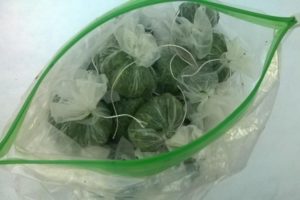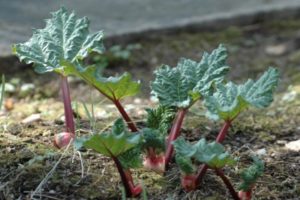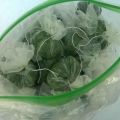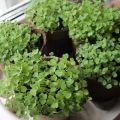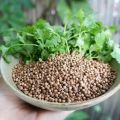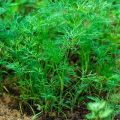Growing arugula in the open field from seeds and seedlings, planting and caring for the country
70% plant food and 30% animal - the proportion of foods that humans need, developed by nutritionists. Plant foods are vegetables, fruits and, of course, greens. Its chemical composition is a richness of the most valuable vitamins and microelements. Arugula is a new, but already well-established type of greenery. Many buy it, and some, having land plots, want to grow it. For this, it is important to learn the rules of planting and care, although arugula in the open field is unpretentious.
Description of the crop: varieties and varieties
This type of greenery is a rather entertaining plant. Presented in two types of salad:
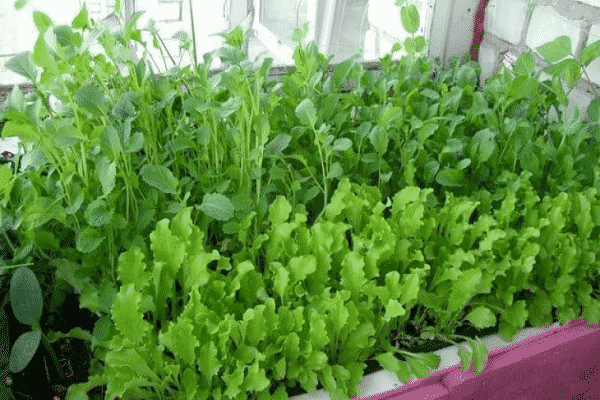
- garden arugula, another designation for indau sowing, or eruka;
- wild arugula, another designation is thin-leaved two-row.
These types of greens have an original flavor that provides ready-made dishes with a delicate nutty taste with a mustard tint. Reproduction takes place through planting seeds.
Arugula is considered a type of salad; it belongs to the Cabbage family, the Indau genus. Previously considered a weed, but after Mediterranean cuisine took root in Europe, it became popular.
There are many varieties of arugula, it is recommended that you familiarize yourself with their characteristics before planting:
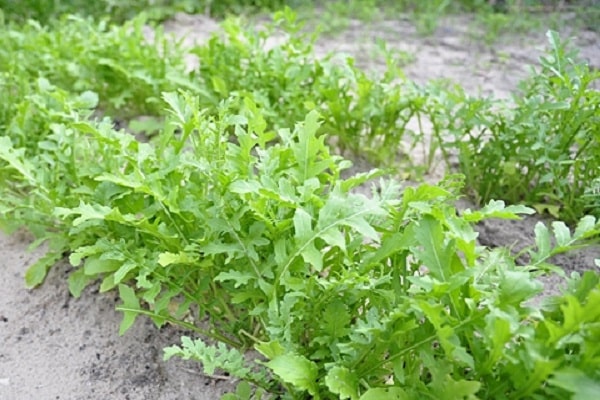
- Arrows of Cupid. Greens are characterized by an average ripening period, the growing season is 35-38 days. The plant grows up to 30 cm, the leaves are narrow and oblong. Outwardly similar to a dandelion, it constantly gives a good harvest.
- Dikovina. The growing season of greenery is 27-30 days, it grows up to 20 cm in height, has an erect stem, blooms with small inflorescences that have a creamy shade. Greens have a sweetish taste, there is no bitterness.
- Poker - has an early ripening period, the growing season is 22-25 days. It is characterized by rich green leaves of relatively large size, one rosette has about 25 pieces. The greenery grows to a height of 20 cm. It has a sweetish taste with some bitterness. Seeds remain viable for up to 4 years.
- Olivette. It is a type of early ripening, the growing season is 20-22 days, the height does not exceed 17-20 cm. This is a perennial variety with slightly rounded leaves. Excellent yield, excellent taste characteristics, there is some nutty flavor and a slight piquant bitterness.
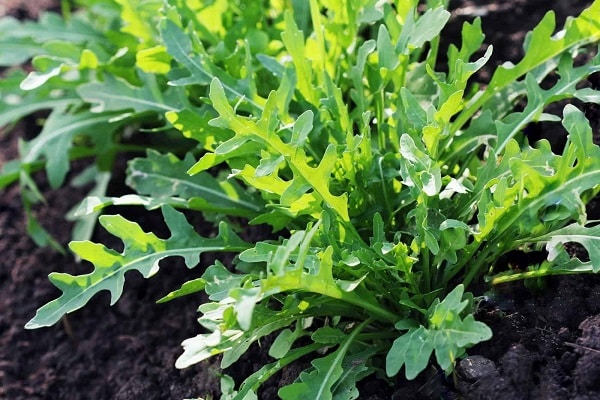
Nuances of growing arugula
Arugula is unpretentious, therefore it is recommended to grow it:
- in the open field: by sowing seeds or by seedling;
- in greenhouse conditions: sowing seeds or seedlings;
- at home: in a suitable container on the windowsill.
Important conditions for a good harvest of greens include a suitable planting site, type of soil, watering, maintenance and timely harvest. To constantly have fresh greens, sowing is carried out at intervals of two weeks.

Selection of quality seeds
The subspecies is determined visually by the type of seeds. The two-row plant has small, more poppy-like seeds (up to 1.3 mm). The seeds of the Indau species are larger, about 2-3 mm in size.
If the seeds were purchased spontaneously, it is recommended to disinfect them by soaking them in a manganese solution. Purchased from specialized vendors do not require any training.
What neighbors can you plant
Arugula is recommended to be planted next to corn, beans and cucumbers climbing on trellises. They create a slight shade for her. It gets along well with dill, carrots, onions, rosemary, potatoes. But you should not plant arugula near strawberries.

Growing arugula outdoors
Arugula is unpretentious, it is grown without problems in the country and in the garden in the open field. Growth technology includes adherence to the method of soil preparation, sowing, caring for greens and timely watering. One of the conditions for a high-quality harvest is the choice of a site for planting. In open ground, this type of greenery is planted in a seedling and non-seedling way.
Good and bad predecessors
It is recommended to plant greens in areas of land where tomatoes, carrots, pumpkin seeds, potatoes and legumes were previously grown. They are good predecessors. But after cabbage, radish, turnip, turnip and horseradish, it is recommended to sow after 3 years due to the presence of similar diseases.

Sowing dates and soil requirements
For growing this plant in the open field, the appropriate planting dates have been determined. This period stretches from late April to mid-August.
It's worth remembering! The earth should warm up to + 10 ... + 13 aboutC. Sowing in cold soil slows down the germination processes.
The plant prefers warmth, although it copes well with the cold, withstands even short frosts up to -5aboutC. For a constant receipt of fresh greens during the summer, it is recommended to sow seeds throughout the season at intervals of 2 weeks. The most delicious and especially healthy leaves are 25 to 45 days old. In warm latitudes, it is allowed to harvest the autumn harvest from September to mid-November.
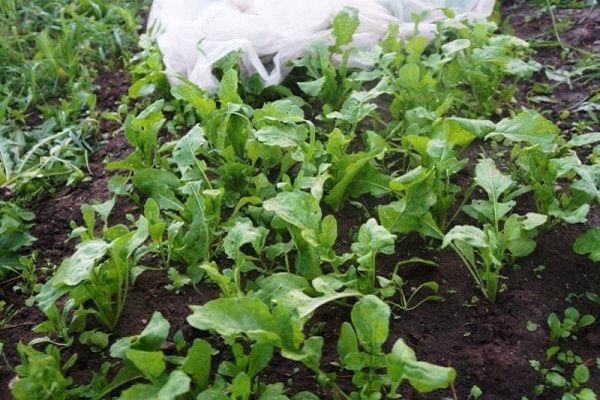
In the south and in the middle latitudes, planting is carried out from the second half of April, in Siberia, in the Moscow region, it is recommended to use cultivation in greenhouse conditions or by seedling. For seedlings, it is recommended to sow seeds in the last days of March or early April.
Seeds do not require pre-treatment, since they have good germination. Seedlings are grown in special boxes, glasses or ordinary pots.
Arugula is allowed to be sown before winter, and then it will be possible to collect early greens. Sowing is carried out with the onset of a stable cold temperature without prolonged warming, they will provoke swelling, and the seeds will germinate, the crop will die. Sowing is done approximately in October-November.

Recommendations for the sowing site:
- preferably moderate lighting, ideal if the greenery will be in shade at noon;
- predominantly neutral, alkaline or slightly acidic soils, it dies on acidic soils, and if the bushes have taken root, they will give poor-quality shoots.
Greens growing in a sunny area go to the arrow, become tough, with a bitter aftertaste, and in a dark area it loses its color and aroma.
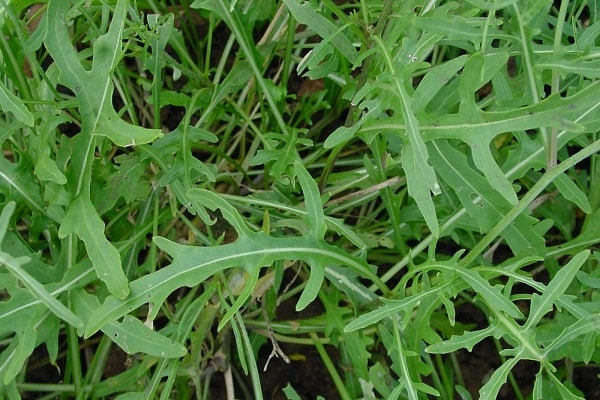
Preparation before landing
Before sowing, you need to carry out preparatory work: loosen and level the soil. With very acidic soil, liming must be carried out; for this, crushed chalk, lime or dolomite flour must be added to it. The concentration is selected based on the condition of the soil, about 25-55 kg per hundred square meters.
If liming was carried out in the fall, in the spring, before sowing, 35-38 g / sq. m azofoski or "Kemira". If in past years the soil was thoroughly fertilized, it is not necessary to make additional fertilizing under this plant. When the earth needs nutrition, it is recommended to enter 35-45 g per m2 during digging2 urea or the corresponding amount of nitrophoska.
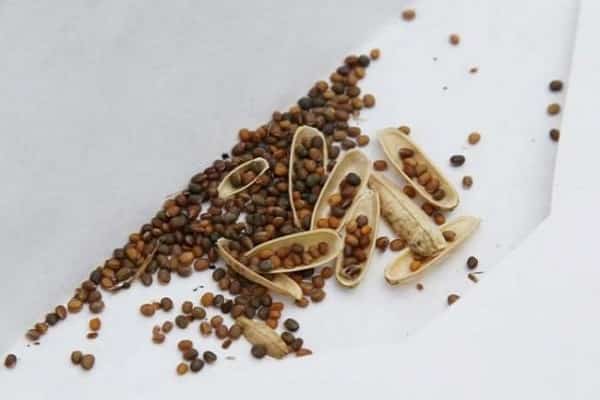
Sowing seeds
To sow arugula seeds, preliminary preparation is not required, the seeds have good germination. Sprouts will appear on the 6th day after sowing.
Sowing is carried out in prepared pits with a depth of 15-20 mm. The gap between the rows is 25-35 cm, it is recommended to leave 5 cm between the holes. 2-3 seeds are laid in each hole.
When two leaves are strengthened on the sprouted shoots, the shoots must be dived into separate containers, and the strengthened shoots are subsequently transplanted into an open area along with a lump of soil so as not to injure the roots.
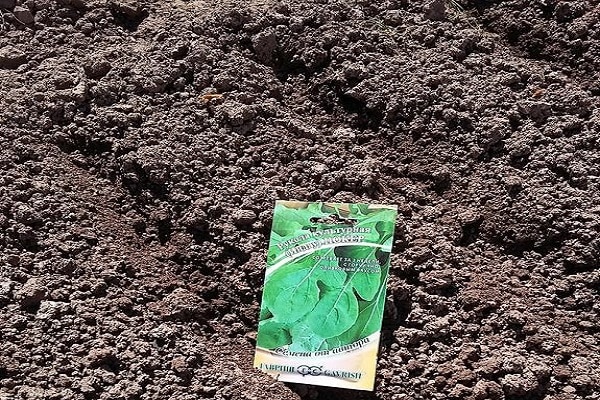
Arugula care
When the shoots sprout, they must be thinned, for this a gap of 5 cm is left between them, and then at the next thinning - 10 cm. Greens that grow too densely lose their taste.
The optimum temperature is + 15… + 18 ºС. It can withstand short-term frosts. If a prolonged cold snap is expected, it is recommended to build a protection from a polyethylene film.
After watering, the soil is mulched, such actions allow you to save moisture and keep greenery from contamination by the ground. It is mulched with grass-chaff or humus. The thickness of the mulch is increased by a couple of centimeters each time. It is distributed under the bushes so that the leaves are not located on the ground.
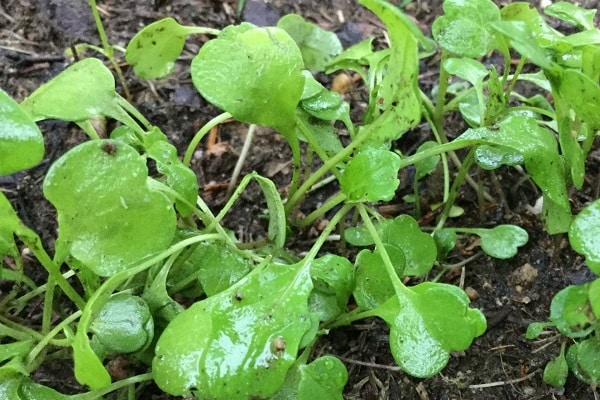
Organization of watering
The plant prefers moist soil. Watering is carried out three times a week. In case of stable heat, it is recommended to exercise it daily.
If there is not enough moisture, the plant will become bitter, release a peduncle and become unusable for human consumption. Arugula prefers moisture, but during watering it is unacceptable for it to stagnate in the upper soil levels.

Weeding and loosening the soil
For good growth, loose soil is needed, respectively, after watering (it is possible every other time), it is recommended to fluff up a plot of land. In this case, weeding is also carried out.
If weeds are not removed, they thicken the crops and provoke the occurrence of fungal diseases. The presence of weeds is reflected in the taste of the greenery.
Plant feeding
The land for sowing is well fertilized. Then, during the growth period, one or two dressings are carried out. It is not recommended to use complex mineral preparations, since the toxins collected in the plant will not decay during a short period of growth.
It is recommended to use a solution of chicken manure or rotted manure as a top dressing. If you wish, you can use nitrogen fertilizing, but remember that the green part quickly accumulates nitrates.
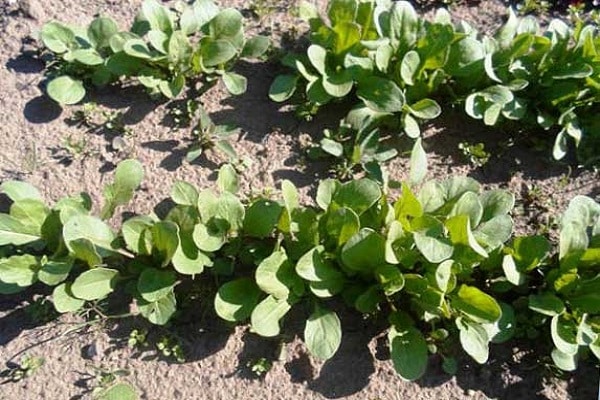
Diseases and pests of arugula
Arugula is classified as early maturing plants, therefore, chemical treatment is not carried out.
However, protection from fungal infections is necessary, these diseases develop mainly in moist soil. If the roots are affected, the stem part will begin to wither. The roots themselves are covered with small brownish bubbles. When these signs appear, it is necessary to remove the affected sprout, and treat the earth with antifungal drugs.
The formation of brown spots on greenery indicates a disease with peronosporosis, and yellowed leaves indicate a defeat by Fusarium.
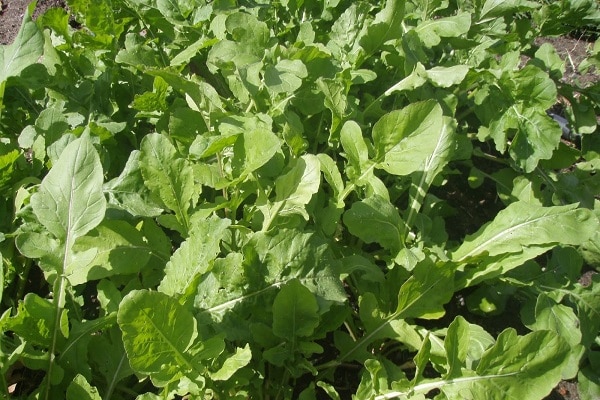
A change in the color of leaves, the formation of spots, lethargy of greenery, or if there is a leafy part in the holes, all this indicates a disease or the presence of pests. To prevent such phenomena, prevention is carried out:
- thorough preparation of the soil;
- it is recommended to sprinkle the soil with wood ash;
- registration of predecessor plants;
- elimination of weeds;
- use of quality seeds.
When signs of fungal and bacterial diseases appear, the use of biofungicides is allowed. Processing is carried out in accordance with the instructions. With a large-scale defeat, it is better to remove and destroy arugula.
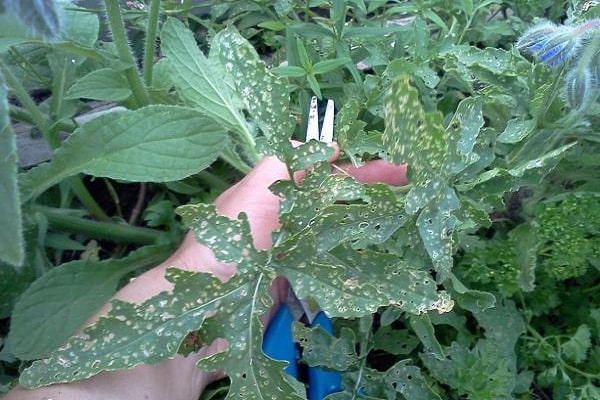
The plant exudes a lot of essential oils, their smell scares pests. Although the greens of arugula attract cabbage caterpillars, cabbage moth and other lepidoptera, also slugs. Arugula greens can also be damaged by a cruciferous flea; they also eat radishes and other types of greens. When covering delicate crops with lutrasil, harmful insects will be forced to look for another food.
Effectively spills out the soil and plants with tobacco dust or fine, pre-sieved ash. Spraying with herbal infusions, in particular wormwood, is not recommended. Staying on the greens, the solution will give it an unwanted flavor.
During the growth of arugula, slugs and caterpillars, if there are not many of them, are harvested by hand. You can apply the treatment of the plant with bioinsecticide, according to the recommendations.
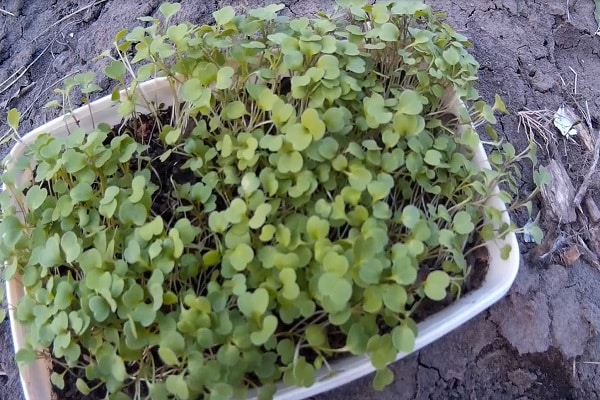
Harvesting and storage of crops
Experienced gardeners know that if you overdo the arugula, the leaves will become tough and taste bitter. It is important to collect herbs from the garden on time. The first of the indicators of maturity is that the length of the leaves should be at least 10 cm.
Important to remember! The taste properties of greens after the appearance of a flowering arrow fall.

Large rosettes need to be cut at the root, the rest of the bushes partially. Leaves are used for making fresh salads. In a cold and dark place, greens are stored, packed in plastic wrap, for several days.
If you follow the simple recommended growing rules, arugula greens will delight you for a long time, during a favorable growing time. And if you master the technology of planting and care at home, greens will be in the diet all year round.

